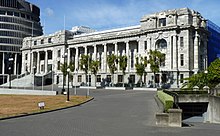| 51st Parliament of New Zealand | |||||
|---|---|---|---|---|---|
| |||||
 | |||||
| Overview | |||||
| Legislative body | New Zealand Parliament | ||||
| Term | 20 October 2014 – 18 August 2017 | ||||
| Election | 2014 New Zealand general election | ||||
| Government | Fifth National Government | ||||
| House of Representatives | |||||
 | |||||
| Members | 121 | ||||
| Speaker of the House | David Carter | ||||
| Leader of the House | Simon Bridges — Gerry Brownlee until 2 May 2017 | ||||
| Prime Minister | Bill English — John Key until 12 December 2016 | ||||
| Leader of the Opposition | Jacinda Ardern — Andrew Little until 1 August 2017 | ||||
| Sovereign | |||||
| Monarch | Elizabeth II | ||||
| Governor-General | Patsy Reddy from 28 September 2016 — Jerry Mateparae until 31 August 2016 | ||||
The 51st New Zealand Parliament was elected at the 2014 general election. This Parliament consists of 121 members (120 seats plus one overhang seat) and was in place from September 2014 until August 2017, followed by the 2017 New Zealand general election. Following the final vote count John Key was able to continue to lead the Fifth National Government.
The Parliament was elected using a mixed-member proportional representation (MMP) voting system. Members of Parliament (MPs) represent 71 geographical electorates: 16 in the South Island, 48 in the North Island and 7 Māori electorates. The remaining members were elected from party lists using the Sainte-Laguë method to realise proportionality. The number of geographical electorates was increased from 70 at the previous election, to account for New Zealand's increasing population.[1]
- ^ "Reviewing electorate numbers and boundaries". Elections New Zealand. Archived from the original on 9 November 2011. Retrieved 6 January 2012.